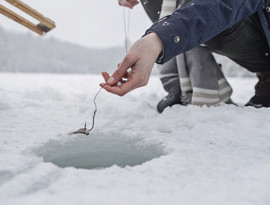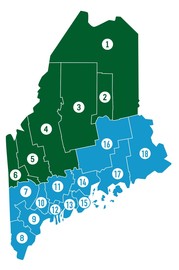Fishing responsibly with live baitfish

Anglers baiting their hooks are the last line of defense stopping the spread of unwanted species. Help protect Maine's fisheries:
- Always check fishing regulations to ensure live baitfish/live smelts are allowed to be used in that water. Remember, live baitfish laws are different in the North and South Zones - learn more.
- At the end of the day or if putting on fresh bait, never put old bait in the water body or down your hole. Dispose of it on land or in the trash.
- Never dump your bait bucket where fish could get into the water. Always dispose of unwanted baitfish on land or in the trash. Dispose of unused worms in the trash, not in the water or on land.
- Nonresident anglers visiting Maine are reminded that it is illegal to bring baitfish into the state of Maine, and those who do are subject to a $10,000 fine. This law prevents new species of fish and invasive hitchhikers in the bait bucket water from being introduced and harming Maine’s fish communities.
With an estimated 90% of baitfish sales occurring during winter, it’s important for anglers to be aware of Maine’s live-bait regulations. Because of the importance of our freshwater ecosystems, we walk a fine line trying to prevent the illegal introduction of harmful fish species while allowing anglers to continue Maine’s cultural tradition of using live baitfish where appropriate.
|
 |

Can I use live fish as bait?
The answer to this question depends on where you are fishing. First, determine if you are fishing in the South Zone or the North Zone:
South Zone: If you are fishing in the South Zone, use of all legal forms of bait (including live baitfish/smelts), artificial lures, and artificial flies is PERMITTED under General Fishing Law.
Exception: Some waters in the South Zone have the “S-4” Special Law Code, meaning use or possession of live fish as bait is prohibited (the use of dead fish, salmon eggs, or worms is permitted.) To see if the water you intend to fish in the South Zone has this special law, look in the Special Fishing Laws to see if the water is listed and has the S-4 code. If the water is not listed under special fishing laws then it falls under General Law and live bait is allowed, if the water is listed but does not have the S-4 code, then live baitfish is allowed.
North Zone: Under the North Zone General Fishing Law, the use or possession of live fish as bait is PROHIBITED, unless the individual water contains Special Fishing Laws to allow the use of live fish as bait. This conservation approach helps protect the abundant native resources in this part of the state.To determine if the North Zone water you wish to fish allows the use of live baitfish, find the water in the Special Fishing Laws section and look for the “S-11” Special Law Code indicating that the use or possession of live baitfish/live smelts is permitted. If your water is in the North Zone, and has that “S-11” Special Law Code, you can use live baitfish/live smelts.
North and South Zone: Waters in both the South and North Zones with Special Law Code "ALO" do not permit live baitfish, worms, or dead baitfish. These waters are artificial lures only.
View answers to other frequently asked questions.
|
Harvesting your own baitfish? Here are a few reminders
- All inland waters (including rivers, streams and brooks) are open to the taking of baitfish for personal use unless designated “closed to the taking of live baitfish” under Special Fishing Laws
-
Legal species only – There are only 17 species of fish that are legal to use as bait while fishing in Maine and therefore, not all fish captured in bait traps are legal to use. If illegal fish species are illegally used as bait, it could establish new populations of fish that harm important state fisheries. A good rule of thumb when sorting collected baitfish is to remove any fish that have spines (check your bait as you are removing them from the trap and put them back into the water from which they were taken). Learn more about legal baitfish.
-
Clean your traps – When bait traps are being used to harvest baitfish, even in the winter, traps should be visually inspected to remove any plant material or other visible debris, washed, and allowed to air dry before placing in a new water. These simple steps will prevent the spread of any invasive plants, microscopic plant seeds, and other small invertebrates that may not be easily observed during inspection.
-
Mark your hole with an evergreen bough so other outdoor users are aware. Label your bait trap with your name and address. Traps must be tended at least once every 7 days by the person who set them.
-
Fishing license required – You must have a valid Maine fishing license to harvest baitfish for personal use. Baitfish may not be sold or harvested with the intent to sell without a bait dealer’s license. Commercial bait dealer licenses can be found online.
-
Trap specifications apply – Baitfish traps may not exceed 50 cubic feet in volume and must be fitted with rigid entrance or exit holes.
Learn more about protecting Maine's waters from invasive species.
Helpful links
Beginner’s Guide to Ice Fishing in Maine
Winter ice safety
Buy a fishing license
Monthly fishing report
Search Maine fishing laws
Fishing Laws Online Angling Tool (FLOAT)
Fishing resources
Current stocking report
Maine Fishing Guide
Fishing with soft plastic lures
Hire a registered Maine guide
|